Anafiotika – a Secret Under the Acropolis
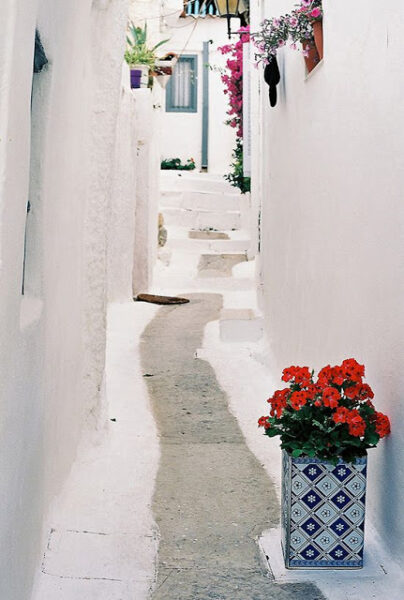
Anafiotika, Athens, Greece. Photo by Cripple House
Would you believe me, if I told you, that you can find the most charming, idyllic, tiny, typically Greek island in the heart of the bustling metropolis of Athens, capital city of Greece?
You would do well to believe me, because it’s there, nestling on the hillside, in the shadow of the Acropolis, a veritable Greek island, made up of little white cubes, houses with brightly painted shutters, perched, as it would seem, one on top of the other, in true Aegean-style.
Only the sparkling blue of the Aegean Sea has vanished.

Anafiotika. A Greek island under the Acropolis
Am I talking about a mythical island, visible to only Greek gods, as they look down from the Parthenon?
No, it exists, in all its glory, a stone’s throw from Plaka, the busiest tourist area in Athens but here, you will not find streets upon streets of souvenir shops, or cheerful taverna owners, enticing you in to taste their wares.
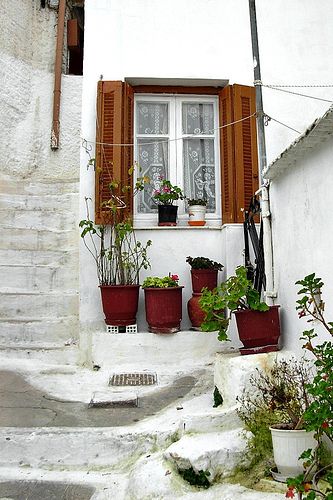
Anafiotika, Athens. Built by the workers of the island of Anafi, Cyclades. Photo Eleanna Kounoupa
This magical place, a white-washed, scenic, secret, under the Acropolis is called Anafiotika but how did it get there?
King Otto of Bavaria and the master builders of Anafi
Following the Greek War of Independence (1821-1832), also known as the Greek revolution, Greeks, after four hundred years of Turkish rule, regained control of their country.
Prince Otto of Bavaria was made first king of independent Greece (1832-1862).

Prince Otto of Bavaria. First King of modern Greece. Joseph Stieler
King Otto’s first task was to build a royal palace; Construction work started in 1836 and was completed in 1843.
The palace served as the residence for Greek monarchs for about a century, it is sometimes still referred to as the “Old Palace”.
Today the King Otto’s palace is the Parliament Buildings, located in Sytagma Square (Constitution Square) Athens.
To build his palace, King Otto brought to Athens, workers from the tiny island of Anafi, renowned for their masonry skills.

Parliament Buildings. Syntagma Square. Athens, Greece.
The Greek Island of Anafi, Cyclades

The island of Anafi. Cyclades. Greece
Anafi, a miniscule gem of an island, in the Northeast Cyclades, neighbor to Santorini, can only be reached by boat and owing to many stops along the way, the journey from Athens may be a long one and could take up to eleven hours!
Anafi is untouched by tourism, a walker’s paradise, wild landscapes and sandy beaches, and only one village, Hora.

The one and only village of Anafi, Hora
In Greek mythology, Anafi is said to have been named by the God Apollo, who made it appear to the Argonauts, as shelter from a ferocious storm.
Anafi derives from the Greek word “ἀνέφηνεν”, meaning, “He made it appear”.
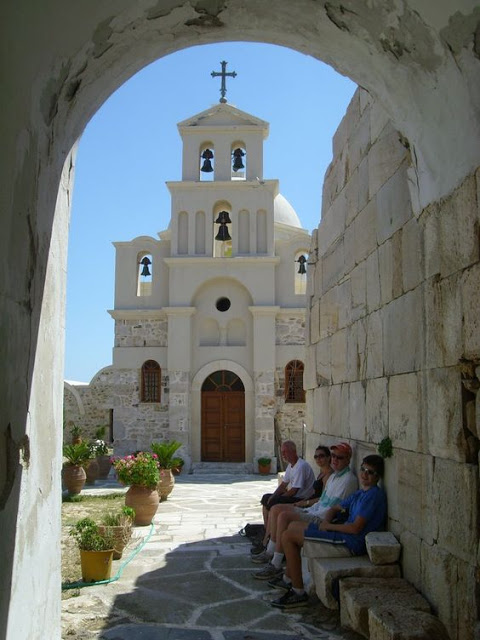
The island of Anafi,Cyclades, Greece
The History of Anafi
In 1204, following the forth crusade, the Cyclades were taken over by the Venetians, Anafi was given by Marco Sanudo, (First Duke of the Duchy of the Archipelago), to Leonardo Foscolo, who became known as Lord of Anafi.
Anafi was returned to the Byzantine Empire, in 1270s, by Licario, another Italian citizen of Anafi, and in 1481, Anafi passed into the hands of the Pisani family, who ruled until 1537, when it was ransacked by the Ottoman Admiral, Hayreddin, and the famous Barbarossa, red beard, who herded up the people of Anafi and carried them away as slaves.
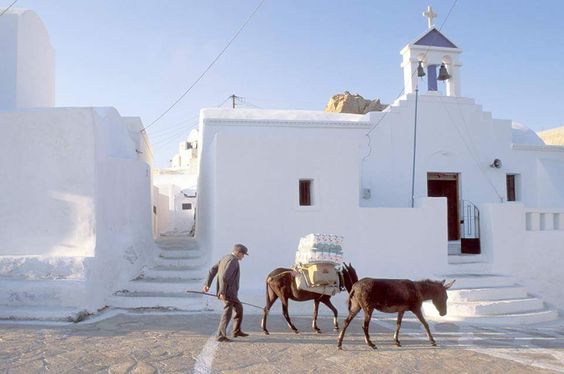
Island of Anafi. Cyclades Greece
In 1700, Anafi was resettled by the Ottoman court and more or less left to its own devices, until The Greek war of independence, when Anafi returned to Greek rule.
From 1920s onwards, Anafi was used as a sort of depository for exiles and political dissidents from the Greek mainland and after the installation of an electricity generator in 1974, and the paving of roads in the late 1980s, Anafi began to attract a few tourists.
The emergence of Anafiotika
Let’s go back to around 1840, when builders from Anafi, summoned by King Otto, to refurbish his palace and transform Athens into a modern capital city, arrived.
During the day, the workers from Anafi, built splendid houses for the crème de la crème of Athens, by night, they built their own humble abodes, under the Acropolis; after all, they had to have somewhere to live

Houses of Anafiotika, built by workers from the island of Anafi, Clyclades
The law, at the time, stated, if, within twenty four hours, you could build four walls and put a roof on those four walls, the land was yours.

Anafiotika, Athens
The Anafi workers, in no time at all, had created a little Anafi and as not to be homesick, they created the area as a replica of the small, Aegean Island they had left behind, narrow winding streets, whitewashed houses, brightly- coloured paintwork, and bougainvillea at every corner, and named it Anafiotika.
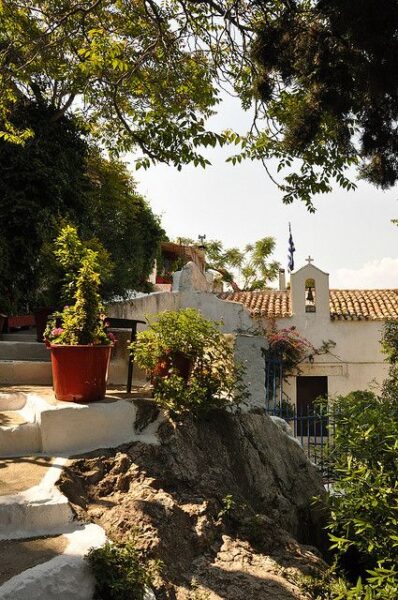
Agos Georgeos, on the southern boundary of Anafiotika
Athens
Two churches were erected, Agios Georgeos, on the southern boundary of Anafiotika and Agios Simeon, on the Northern boundary.

Agios Semeon. On the northern boundary of Anafiotika. Athens
In the 50s, Archeological research, after all, this is the area of the most historic place in Greece, meant knocking down some of the houses and later, in the 70’s, someone, in my opinion, not in their right mind, ordered many of the beautiful old houses, to be destroyed, as they did not have planning permission!

Anafiotika. Athens
Today only about forty five of the original houses, built by the workers of Anafi remain, the narrow little streets, built in true Cycladic style, are unnamed, as they were back in the eighteen hundreds, they are differentiated only by number, Anafiotika 1, Anafiotika 2, Anafiotika 3 etc.

Anafiotika. A secret under the Acropolis
Do you believe me now?
Here, in the heart of Athens, in the heat of the city, is a refreshing breath of island life; tranquility after the hustle and bustle of plaka, here, you really could say, time has stood still.
This is Anafiotiaka



